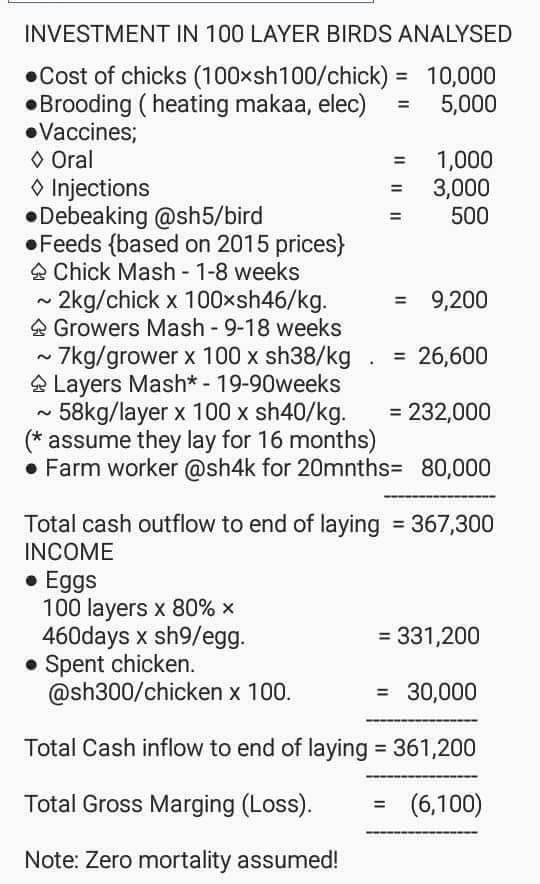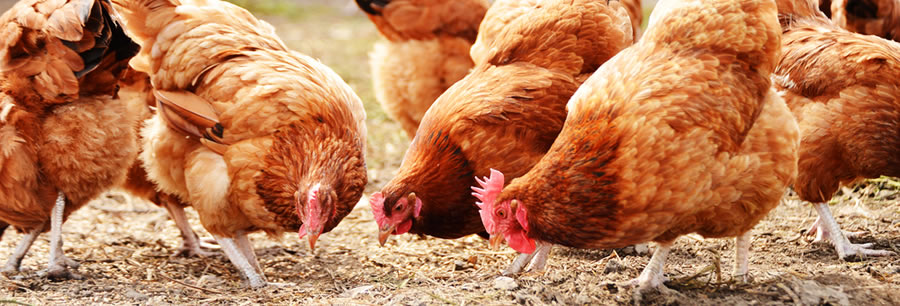I have just chanced upon this post on the African Farmers Club Facebook Group where a farmer from Bomet is claiming that he sees zero profits in poultry farming. As a poultry farmer myself, I know that poultry farming is a low margin business and you can only make significant revenues and profits if you do the economies of scale, that is, raise thousands of chickens and do your utmost to maximize on the productivity of your chicken, be they commercial layers, commercial broilers, Rainbow Roosters, Kuroilers or the KARI Improved Kienyeji Chicken.


It is true that there are many factors that make poultry farming a pain for many farmers such as the cost of feeding, diseases and high rates of mortality, labor costs and low egg prices. These will eventually lead to massive losses for many poultry farmers. However, many of these are factors that can be mitigated in order to maximize on your profitability.
There are certain poultry farming costs that are “constants”. These include costs such as vaccination, cost of chicks, cost of equipment and even feed costs. The prices don’t fluctuate wildly.
As a farmer, you have to factor in these costs and plan ahead. Don’t just run with these costs and cry foul. Ask yourself how you can cut down on these costs and maximize on your poultry farming profitability.
You can reduce the cost of poultry production in multiple ways:-
- Economies of Scale: To begin seeing tangible monetary benefits from your poultry farming venture, start raising more chickens. We suggest raising 300 chickens and above to be profitable.
- Look for ways to cut down on costs of production: There are multiple ways in which you can cut down on cost of production without impacting the health and productivity of your birds. For example, you can improvise on poultry equipment and make your own with timber instead of purchasing new ones; you don’t have to hire costly labor if you or your partner can do the job. When it comes to poultry feeds, look for areas where you can make some savings. A few hundred shillings in savings can mean a lot when you stretched over several months or several bags. Where else do you see yourself cutting down on the cost of production? Generally, if you have less than 100 birds, it is possible to manage the labor by yourself.
- Make your own poultry feeds: While you can cut down on costs in multiple ways, the biggest target should be in the poultry feeds. Poultry feeds make up close to 70% of the production cost so cutting down your cost of feeding will make a huge difference in your overall cost-cutting plans in your poultry farming enterprise. You don’t cut down on the cost of feeding by underfeeding your birds. The best way to go about this is by formulating your own poultry feeds. Contrary to popular perception, formulating your own poultry feeds isn’t too difficult. For Kienyeji feed formulation, check out our manual on poultry feed formulation for a step-by-step guide on how to make your own poultry feeds.
- Avoid certain costly practices: There are certain chicken husbandry practices that cost money and which may not be necessary. These include debeaking your chickens and using too much antibiotics as well as vitamins. When it comes to medication, consult a vet and use only the right amount when necessary. Before utilizing any of these, always consult a professional in order to cut down on costs.
- Have some patience: If you are moving into poultry farming to make quick money, you are most likely going to be disappointed because you are not going to make quick cash from poultry farming. You will realize that poultry farming, be it commercial or kienyeji chicken farming, requires greater patience. Poultry farming is typically a long term investment and you will not get profits the very first time you get into the enterprise. Depending on the scale of the project, it might actually take you years to break even in your poultry enterprise. Generally, the longer you stay in the poultry farming enterprise, the higher the likelihood that you are going to make significantly more profits.
- Manage Diseases: Poultry diseases and mortality are the leading causes of loss in productivity and yields yet only a few farmers take proactive steps to effectively manage poultry diseases and cut down on losses. Start practicing proper biosecurity and you will cut down on your cost of production significantly.
- Good marketing: With good poultry marketing, you can cut out the middlemen or brokers and increase your margins significantly. By investing in proper poultry marketing, you are going to run a more successful poultry farming enterprise.
- Acquire more knowledge: Knowledge is power, more so when it comes to a delicate enterprise such as poultry farming. Don’t rely on Google and hearsay alone; take time to master practical experience in poultry raising before you venture into the business. Read manuals, attend training and visit farms to learn more about the best practices before you venture into the practice.
- Be Realistic: The biggest mistake many first-time farmers make is venturing into poultry farming with unrealistic expectations on what the venture can earn them. For example, a KARI Kienyeji or Kuroiler will not give you more eggs than hybrid commercial layers and don’t expect to be an instant poultry millionaire.
- Avoid Me Too Syndrome: Don’t just venture into poultry farming because a friend is doing it or because you read it somewhere. Take time to evaluate what it takes and whether you have the time and resources to commit into the project. The fact that it works for a friend does not automatically mean it will work for you.